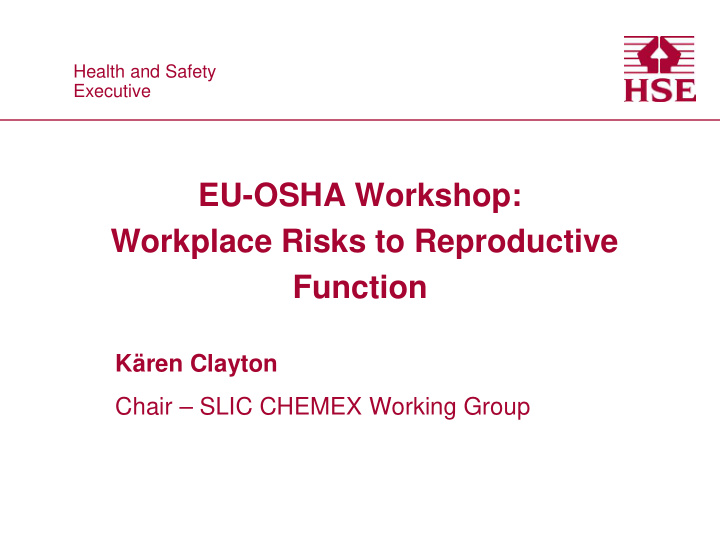



Health and Safety Health and Safety Executive Executive EU-OSHA Workshop: Workplace Risks to Reproductive Function Kären Clayton Chair – SLIC CHEMEX Working Group
EU-OSHA Workshop: Workplace Risks to Reproductive Function The Senior Labour Inspector Committee’s (SLIC) working group for exchanges on Chemicals (CHEMEX): • Initially set up to focus on REACH enforcement; • A new mandate has recently been agreed; • The future work plan for CHEMEX is undecided and still has to be agreed.
EU-OSHA Workshop: Workplace Risks to Reproductive Function There is an EU regulatory framework covering substances presenting an occupational risk to reproductive function, this includes: • Registration, Evaluation, Authorisation & restriction of CHemicals (REACH) Regulation • The Chemical Agents Directive (CAD) • The Carcinogens and Mutagens Directive (CMD) • The Pregnant Workers Directive (PWD)
EU-OSHA Workshop: Workplace Risks to Reproductive Function • REACH : An important part of chemical safety is the provision of clear information about any hazardous properties of a substance, REACH provides a framework in which information can be passed up and down supply chains. • Downstream users should be able to understand what manufacturers and importers know about the dangers involved in using chemicals and how to control those risks.
EU-OSHA Workshop: Workplace Risks to Reproductive Function CAD includes s ubstances toxic to reproduction and requires employers to carry out an assessment to establish the risks, (including those to reproductive function) associated with products and processes they are using and to then put preventative measures in place. CAD also requires employers to provide suitable and sufficient information, instruction and training for anyone exposed to substances hazardous to health (including those to reproductive function) in the workplace. CMD was implemented to protect workers from the risks related to exposure to carcinogens/mutagens (this could also include some substances that also pose a risk to reproductive function) in the workplace. For both CAD and CMD risks can arise from any work process involving biological or chemical agents .
EU- OSHA Workshop: Workplace Risks to Reproductive Function PWD requires employers to undertake a risk assessment which should include any specific risks to pregnant workers and workers who have recently given birth or who are breast feeding. These risks can be from any process, working conditions, or physical, biological or chemical agents .
EU- OSHA Workshop: Workplace Risks to Reproductive Function The UK has a regulatory framework for hazardous substances ‘The Control of Substances Hazardous to Health Regulations (COSHH)’ which implements both CAD & CMD and includes substances that pose a risk to reproductive function. Other Member States have implemented CAD & CMD in different ways, with some specifically including substances that pose a risk to reproductive function into their legal framework.
EU-OSHA Workshop: Workplace Risks to Reproductive Function From an OSH regulator’s perspective does more need to be done?– it is not clear yet as there is still a need to better understand: • whether exposures occur in the workplace or are from other routes e.g. food/drink/environment, • other lifestyle factors, • where the problems are and who is being exposed so that any intervention can be targeted, • how best to increase compliance with current legislation by raising awareness and changing employer and employee behaviour, • that there are no quick fixes – we are still trying to address ‘historical’ problems (e.g. lead) and a long term commitment is needed, and to recognise that to be successful there has to be a mix of interventions and agencies involved.
EU-OSHA Workshop: Workplace Risks to Reproductive Function Thank you for listening!
Recommend
More recommend